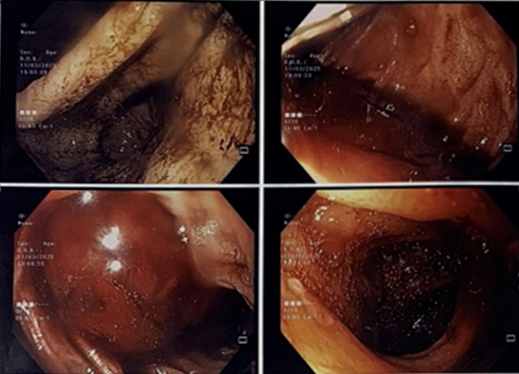Duodenal Ulcer Complicated with Massive Upper Gastrointestinal Bleeding: Case Report
Main Article Content
Abstract
This case report aims to present a severe manifestation of duodenal ulcer complicated by massive upper gastrointestinal bleeding and critically low hemoglobin levels, highlighting the importance of early recognition, immediate intervention, and a multidisciplinary approach in managing patients at imminent risk of hemodynamic instability. A 64-year-old male patient with a recent history of orthopedic surgery and exploratory laparotomy was admitted to the emergency department in a coma, presenting signs of hemodynamic instability, severe anemia (hemoglobin 2.8 g/dL), metabolic acidosis, elevated lactate levels, and clinical features of septic shock originating from a surgical wound infection. The patient was intubated, received fluid resuscitation and blood component transfusion, and was admitted to the intensive care unit (ICU). Emergency upper gastrointestinal endoscopy revealed an actively bleeding duodenal ulcer classified as Forrest IB, with abundant clots. Despite endoscopic treatment with adrenaline injection, hemodynamic instability persisted, necessitating surgical intervention. Exploratory laparotomy confirmed a 30 mm bleeding ulcer, which was treated with duodenorrhaphy and omentoplasty. The patient showed clinical improvement postoperatively and was transferred from the ICU to the surgical ward. This case underscores the importance of prompt diagnosis and timely intervention in patients with severe upper gastrointestinal bleeding due to duodenal ulcer.
Article Details

This work is licensed under a Creative Commons Attribution 4.0 International License.
Authors retain the copyright of their articles and grant the journal the right of first publication under the Creative Commons Attribution (CC BY) license, which allows others to share and adapt the work with proper attribution.
References
Ket SN, Sparrow RL, McQuilten ZK, Gibson PR, Brown GJ, Wood EM. Critical peptic ulcer bleeding requiring massive blood transfusion: outcomes of 270 cases. Intern Med J. 2021;51(12):2042–50. doi:10.1111/imj.15009.
Segovia Lohse HA, Segovia Lohse HR. Upper gastrointestinal bleeding. In: Coccolini F, Catena F, editors. Manual of Emer-gency General Surgery. Cham: Springer; 2023. p. 1–7. doi:10.1007/978-3-031-22599-4_69.
Laine L, Jensen DM. Management of patients with ulcer bleeding. Am J Gastroenterol. 2012;107(3):345–60. doi:10.1038/ajg.2011.480.
Kurokawa T, Arikawa T, Sano T, Nonami T. Surgical Treatment: Sugiura Procedure and Hassab Operation. In: Obara K, editor. Clinical Investigation of Portal Hypertension. Singapore: Springer; 2019. p. 433–42. doi:10.1007/978-981-10-7425-7_43.
MacLaren R, Dionne JC, Granholm A, et al. Society of Critical Care Medicine and American Society of Health-System Pharmacists Guideline for the Prevention of Stress-Related Gastrointestinal Bleeding in Critically Ill Adults. Crit Care Med. 2024;52(8):e421-e430. doi:10.1097/CCM.0000000000006330.
